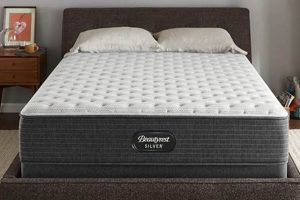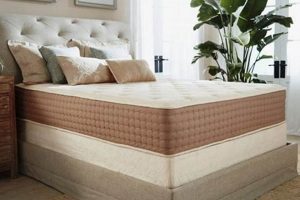An adjustable air bed featuring a mattress offers users the capacity to modify the firmness level to suit individual comfort preferences. This type of sleep surface incorporates air chambers within the mattress core, allowing for inflation or deflation to achieve a desired feel. For instance, one individual might prefer a firmer sleep surface achieved through higher inflation, while another may opt for a softer feel by reducing the air pressure within the chambers.
The significance of a customizable sleep environment lies in its potential to improve sleep quality and address specific physical needs. Adjustability can accommodate varying sleep positions, alleviate pressure points, and cater to individuals with back pain or other musculoskeletal issues. Historically, adjustable beds focused primarily on angle adjustments for medical purposes; however, the integration of air chambers for firmness control represents an evolution in personalized sleep solutions.
The subsequent sections will examine the various features, technologies, and considerations involved in selecting a high-quality adjustable air bed mattress. Focus will be placed on durability, ease of use, and the long-term value proposition offered by these advanced sleep systems. Discussion will also include a comparative analysis of available models and their suitability for different user profiles.
Guidance on Optimizing an Adjustable Air Bed Mattress
Maximizing satisfaction with an adjustable air bed mattress requires careful consideration of several factors, from initial setup to ongoing maintenance. These guidelines provide a framework for optimizing the sleep experience and ensuring the longevity of the product.
Tip 1: Understand the Inflation Mechanism: Familiarize yourself with the mattress’s inflation system. Determine the location of the air pump, and understand how to precisely control air pressure levels. Avoid over-inflation, which can damage the internal components.
Tip 2: Conduct Gradual Adjustments: When seeking the ideal firmness, make small, incremental changes. A slight alteration in air pressure can significantly impact comfort. Allow several nights to assess the effect of each adjustment before making further modifications.
Tip 3: Utilize Dual-Zone Settings Thoughtfully: If the mattress features dual-zone adjustability, leverage this capability to accommodate differing comfort preferences for each sleeper. Ensure individual zones are correctly calibrated to provide optimal support and pressure relief.
Tip 4: Employ a Mattress Protector: Protect the air bed mattress from spills, stains, and wear. A quality mattress protector can extend the lifespan of the product and maintain a sanitary sleep environment.
Tip 5: Implement Proper Support: Ensure the air bed mattress is placed on a solid, level foundation. An inadequate base can compromise the mattress’s structural integrity and affect its performance.
Tip 6: Address Leaks Promptly: Regularly inspect the mattress for leaks. If a leak is suspected, consult the manufacturer’s instructions for repair procedures. Small leaks can often be patched, preventing the need for a complete replacement.
Tip 7: Review Weight Restrictions: Adhere to the manufacturer’s specified weight limits. Exceeding these limits can strain the air chambers and compromise the mattress’s longevity.
Implementing these tips can improve the overall experience and ensure prolonged usability. Proper management of inflation, protection, and support will yield maximum enjoyment and longevity.
The subsequent discussion will provide insights into common issues and how to resolve them, with the intention of offering comprehensive guidance for users.
1. Firmness Customization
Firmness customization stands as a core attribute distinguishing adjustable air bed mattresses. It provides individuals with the capability to tailor the sleep surface to their specific comfort preferences, contributing significantly to overall sleep quality and physical well-being. The degree and precision of this customization directly influence the perceived value and efficacy of such mattresses.
- Individualized Comfort Preferences
Sleep preferences vary considerably among individuals. One sleeper might require a firm surface for optimal spinal support, while another might prefer a softer feel for pressure relief. Firmness customization allows for the modulation of mattress feel to accommodate these diverse needs. For instance, a side sleeper might deflate a portion of the mattress to allow the shoulder to sink in, while a back sleeper might inflate the lumbar region to provide additional support.
- Accommodation of Physical Conditions
Certain physical conditions, such as back pain, arthritis, or fibromyalgia, can necessitate specific support levels. Firmness customization provides the means to fine-tune the mattress to address these needs. Individuals with back pain might benefit from a firmer surface to maintain spinal alignment, while those with arthritis might require a softer surface to minimize pressure on sensitive joints.
- Adaptation to Sleep Position Changes
Many individuals shift sleep positions throughout the night. Firmness customization enables the mattress to adapt to these changes. A mattress that can be adjusted from firm to soft allows for comfortable transitions between side, back, and stomach sleeping positions, thereby promoting uninterrupted sleep.
- Dual-Zone Customization for Partners
Couples often have differing sleep preferences. Dual-zone firmness customization allows each partner to adjust their respective side of the mattress independently. This feature prevents compromise and ensures that both individuals can achieve their ideal sleep surface, leading to improved sleep quality for both parties.
The integration of these customization facets within the design of an adjustable air bed mattress enhances its capacity to meet individual sleep requirements. These adaptations, in turn, can potentially improve sleep quality and offer relief from certain discomforts, justifying the higher investment associated with such mattresses.
2. Support and Alignment
The efficacy of any mattress, including an adjustable air bed model, hinges significantly on its capacity to provide adequate support and maintain proper spinal alignment. The connection between “Support and Alignment” and a “best adjustable air bed mattress” is causal; a mattress failing to deliver these core functions cannot be considered a high-quality option. Support refers to the mattress’s ability to prevent excessive sinking and maintain a stable sleep surface, while alignment pertains to its capacity to keep the spine in a neutral posture, m
inimizing stress on joints and muscles. Consider an individual with scoliosis; inconsistent support could exacerbate spinal curvature, leading to increased pain and discomfort. Conversely, a well-supported spine promotes muscle relaxation and reduces the risk of developing or aggravating musculoskeletal issues. Thus, the ability of a mattress to properly position the spine is not merely a matter of comfort, but a crucial element in maintaining long-term spinal health.
Adjustable air bed mattresses offer a distinct advantage in this regard due to their customizable firmness levels. By manipulating the air pressure within the mattress chambers, users can fine-tune the support to match their individual anatomical needs and preferred sleeping positions. For instance, a heavier individual might require a firmer setting to prevent excessive compression of the mattress, ensuring adequate support. Conversely, a lighter individual might benefit from a softer setting to allow for more contouring and pressure relief. Dual-zone adjustable models further enhance this capability, allowing couples with differing body types or sleep preferences to customize their respective sides of the mattress independently. The practical significance of this adjustability lies in the potential to alleviate existing pain conditions, prevent the development of new musculoskeletal issues, and promote restorative sleep by reducing tossing and turning caused by discomfort.
In conclusion, the relationship between “Support and Alignment” and a “best adjustable air bed mattress” is fundamental. A mattress’s ability to provide proper support and maintain spinal alignment is paramount to its overall effectiveness. The adjustability inherent in air bed models provides a mechanism for tailoring support to individual needs, offering a potential advantage over traditional mattresses. The practical understanding of this connection empowers consumers to make informed decisions, prioritizing mattresses that demonstrably promote spinal health and overall well-being. However, challenges remain in ensuring consistent performance and long-term durability, underscoring the importance of selecting models from reputable manufacturers with comprehensive warranties.
3. Durability of Materials
The longevity and performance of any mattress, particularly adjustable air bed models, are inextricably linked to the inherent durability of the materials employed in their construction. Given the dynamic nature of air bed mattresses, with their reliance on pressurized air chambers and mechanical components, material integrity becomes a paramount consideration in determining their overall value and lifespan.
- Air Chamber Composition
The air chambers within an adjustable air bed mattress are subject to constant stress from inflation, deflation, and the weight of the sleeper. Materials such as vulcanized rubber, reinforced PVC, or multi-layered polymers are commonly used. The quality and thickness of these materials directly impact the chamber’s resistance to punctures, leaks, and seam failures. For instance, an air chamber constructed from thin, unreinforced PVC is far more susceptible to damage than one composed of a thick, multi-layered polymer with reinforced seams, ultimately leading to premature mattress failure.
- Support Core Structure
The support core, which surrounds and encases the air chambers, provides structural stability and contributes to overall comfort. Materials such as high-density foams, convoluted foams, or individually wrapped coils are often utilized. The density and resilience of these materials determine their ability to maintain their shape and provide consistent support over time. A support core composed of low-density foam is likely to compress and degrade more rapidly than one made from high-density, resilient foam, negatively affecting both comfort and spinal alignment.
- Cover Fabric and Stitching
The outer cover fabric serves as the first line of defense against wear and tear, protecting the underlying components from spills, stains, and abrasion. Materials such as quilted cotton, bamboo blends, or synthetic fabrics are common choices. The quality of the fabric, combined with the strength and integrity of the stitching, determines the cover’s ability to withstand repeated use and cleaning. A cover made from thin, loosely woven fabric with weak stitching is prone to tearing and fraying, compromising both the aesthetic appeal and the protective function of the mattress.
- Pump and Valve Mechanisms
The inflation pump and valve system are crucial components responsible for controlling air pressure within the chambers. Materials such as durable plastics, metals, and rubber seals are used in their construction. The quality of these materials determines the pump’s reliability, efficiency, and lifespan. A pump constructed from flimsy plastic components with poorly sealed valves is likely to malfunction or fail prematurely, rendering the mattress unusable.
In summation, the “Durability of Materials” is a central factor when considering the “best adjustable air bed mattress”. Attention to the quality and composition of the air chambers, support core, cover fabric, and inflation mechanisms can significantly impact the long-term performance, comfort, and overall value of the mattress. Opting for models constructed from high-quality, durable materials ensures a prolonged lifespan and sustained performance, representing a sound investment in long-term sleep quality.
4. Inflation System Reliability
The functionality of an adjustable air bed mattress is intrinsically linked to the reliability of its inflation system. A malfunction within this system negates the mattress’s core value proposition: the capacity to customize firmness levels for individual comfort and support. A compromised inflation system transforms a potentially beneficial sleep surface into an unusable product. For example, a faulty pump that is incapable of maintaining the selected air pressure renders the adjustability feature moot, leaving the user with an inadequately supported or excessively firm sleep surface. The degree to which the inflation system can maintain consistent air pressure and provide precise adjustments directly dictates the usefulness of the mattress. Therefore, a robust and dependable inflation system is not merely a component of a high-quality adjustable air bed mattress; it is the foundational element upon which the entire design is predicated.
The practical implications of inflation system reliability extend beyond immediate comfort. A system prone to leaks or failures necessitates frequent repairs or replacements, incurring additional costs and disrupting sleep schedules. Furthermore, inconsistent inflation can lead to uneven support, potentially exacerbating pre-existing back pain or contributing to the development of new musculoskeletal issues. Consider a scenario where one side of a dual-zone adjustable mattress gradually loses air pressure overnight due to a faulty valve. The resulting unevenness could cause spinal misalignment and discomfort for the sleeper. Conversely, a reliable system with a consistent and accurate pump enables users to fine-tune the mattress to address specific physical needs, promoting better sleep quality and reducing the risk of discomfort. Thus, in a high-quality system the operational elements provide the expected l
evels of performance throughout the products expected life.
In summary, inflation system reliability is a critical determinant of an adjustable air bed mattress’s overall quality and utility. The capacity to consistently and accurately adjust firmness levels is the primary benefit of these mattresses, and this functionality is entirely dependent on the reliability of the inflation system. While advancements in materials and design have improved the durability and longevity of these systems, challenges remain in ensuring consistent performance over extended periods. Choosing a product from a manufacturer known for quality and offering a comprehensive warranty is crucial in mitigating the risks associated with inflation system failure.
5. Temperature Regulation
The correlation between temperature regulation and adjustable air bed mattresses centers on the sleeper’s thermal comfort. A mattress that fails to dissipate heat effectively can lead to overheating, restlessness, and disrupted sleep cycles. Temperature regulation, therefore, is a fundamental attribute of a high-quality sleep surface. Air bed mattresses, due to their construction involving air chambers, can potentially trap heat, exacerbating the issue. An individual experiencing night sweats, for example, would find little respite on a mattress lacking adequate ventilation and moisture-wicking properties. Consequently, the implementation of temperature-regulating technologies and materials is crucial for optimizing sleep quality in adjustable air bed designs. The absence of such features can negate the benefits of adjustable firmness, as thermal discomfort overshadows the advantages of customizable support.
Practical application of temperature regulation in adjustable air bed mattresses manifests in various forms. Breathable cover fabrics, such as those incorporating bamboo or Tencel fibers, facilitate airflow and moisture evaporation, reducing heat buildup. The integration of gel-infused memory foam layers, positioned above or within the air chambers, absorbs and dissipates body heat. Some manufacturers incorporate ventilation channels within the foam layers to further enhance airflow. The effectiveness of these technologies can be assessed through objective metrics, such as thermal resistance measurements and subjective user feedback on sleep quality and perceived temperature. A mattress demonstrating low thermal resistance and positive user reports on temperature regulation is more likely to provide a comfortable sleep environment. The failure to adequately regulate temperature can compromise the sleep experience, leading to increased tossing and turning, and reduced restorative sleep.
In summary, temperature regulation is a critical, and expected, component of “best adjustable air bed mattress”. A mattress’s ability to effectively manage heat and moisture is paramount to ensuring a comfortable and restorative sleep experience. Despite advancements in materials and design, challenges remain in achieving optimal temperature regulation across diverse climates and individual physiological profiles. Future innovations should focus on developing more effective heat-dissipating materials and ventilation systems. Prioritizing temperature regulation alongside adjustable firmness and support is essential for manufacturers aiming to deliver truly high-quality adjustable air bed mattresses.
Frequently Asked Questions
The following questions address common inquiries and concerns regarding adjustable air bed mattresses, providing informative answers to aid in understanding their features, benefits, and limitations.
Question 1: What is the typical lifespan of an adjustable air bed mattress?
The lifespan of an adjustable air bed mattress varies depending on factors such as construction quality, materials used, and usage frequency. Generally, one can anticipate a lifespan of 7 to 10 years with proper care and maintenance.
Question 2: Are adjustable air bed mattresses suitable for individuals with back pain?
Adjustable air bed mattresses can offer potential benefits for individuals with back pain due to their customizable firmness levels. However, consulting with a healthcare professional is advisable to determine the most appropriate mattress type and firmness setting for specific back pain conditions.
Question 3: How often should the air pressure be adjusted in an adjustable air bed mattress?
The frequency of air pressure adjustments depends on individual comfort preferences and any changes in physical condition or sleeping habits. It is recommended to monitor comfort levels regularly and make adjustments as needed to maintain optimal support and alignment.
Question 4: What is the weight capacity of a typical adjustable air bed mattress?
Weight capacities vary among different models of adjustable air bed mattresses. Most models are designed to accommodate a combined weight of up to 500 pounds, but it is crucial to consult the manufacturer’s specifications for the specific weight limit of a particular mattress.
Question 5: Can adjustable air bed mattresses be used with adjustable bed frames?
Yes, adjustable air bed mattresses are generally compatible with adjustable bed frames, allowing for simultaneous customization of firmness and incline. However, it is important to verify compatibility with the specific bed frame model to ensure proper fit and function.
Question 6: What is the best way to address a leak in an adjustable air bed mattress?
The best approach to addressing a leak depends on the size and location of the leak. Small leaks can often be repaired with a patch kit specifically designed for air mattresses. Larger leaks or leaks in critical areas may require professional repair or mattress replacement. Consulting the manufacturer’s warranty and instructions is recommended.
In summary, adjustable air bed mattresses provide customizable support and comfort, offering potential benefits for various sleep preferences and physical conditions. Proper maintenance, understanding their limitations, and selecting a reputable brand are crucial for maximizing satisfaction and longevity.
The subsequent section will delve into the current market landscape of adjustable air bed mattresses, examining leading brands, models, and technological advancements.
Conclusion
The preceding analysis has elucidated the multifaceted nature of selecting a high-quality sleep surface. Critical considerations extend beyond mere initial comfort, encompassing long-term durability, support efficacy, inflation system reliability, and thermal regulation. Each of these components contributes significantly to the overall performance and value proposition of a sleep solution. Understanding these aspects allows for a more informed and discerning purchasing decision.
The pursuit of an optimal sleep environment is a continuous endeavor, driven by individual needs and evolving technological advancements. It is incumbent upon consumers to remain informed and prioritize objective assessments of product features, construction quality, and warranty provisions. A well-researched decision, grounded in a comprehensive understanding of available options, will yield the most satisfactory outcome.


![Top-Rated Best Split King Adjustable Mattress [Guide] Organic & Natural Mattress Buyer’s Guide: Non-Toxic Sleep Solutions Top-Rated Best Split King Adjustable Mattress [Guide] | Organic & Natural Mattress Buyer’s Guide: Non-Toxic Sleep Solutions](https://mattressworldpa.com/wp-content/uploads/2025/07/th-7682-300x200.jpg)


![Top Best Mattress Black Friday Deals of [Year] for Sleep! Organic & Natural Mattress Buyer’s Guide: Non-Toxic Sleep Solutions Top Best Mattress Black Friday Deals of [Year] for Sleep! | Organic & Natural Mattress Buyer’s Guide: Non-Toxic Sleep Solutions](https://mattressworldpa.com/wp-content/uploads/2025/07/th-7679-300x200.jpg)

